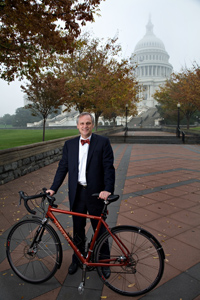 For a guy who’s dedicated his life to public service and is perhaps the politician most closely associated with forward-thinking transportation policy, Rep. Earl Blumenauer, D-OR, says it’s not elected officials who drive progressive thinking when it comes to creating livable communities.
For a guy who’s dedicated his life to public service and is perhaps the politician most closely associated with forward-thinking transportation policy, Rep. Earl Blumenauer, D-OR, says it’s not elected officials who drive progressive thinking when it comes to creating livable communities.
And Blumenauer knows livable communities, having lived his life in one of the nation’s most living-friendly — Portland. He went to Portland’s Lewis & Clark College, served in the State Legislator, was a Multnomah County Commissioner, served on the Portland City Council, was Portland’s Commissioner of Public Works, and has served in the U.S. House of Representatives, where he’s currently on the Ways and Means and Budget committees. And he’s played a pivotal role in Portland’s transformation from another American city beholden to pavement into a city that now:
- Has the highest share of bicycle commuters (6 percent to 8 percent) of any major metro area in the country.
- Is the only large city to earn The League of American Bicyclists’ platinum status as a bicycle-friendly city.
- Has 324 miles of bikeways, which are broken into four types: 1.Traditional on-street bike lanes(202 miles); 2. Neighborhood greenways/bike boulevards, or residential streets where safe, comfortable cycling is the top priority (46 miles); 3. Off-street, multi-use, car-free, paved lanes that typically located in public parks and along former rail corridors (76 miles); and, 4. Cycle tracks, painted buffer zone and parked cars separates cyclists from motorized traffic (less than one mile, with more under construction.)
It’s a scenario that a growing contingent of Triangle residents would love to see happen here, and a large contingent of that contingent turned out Thursday at appearances in Durham and Raleigh to hear Blumenauer describe Portland’s transittopia — and how the city got there. The “how it got there” part was surprisingly straightforward — and encouraging.
“Fifty years ago, Portland was a typical medium-size American city — in a gorgeous setting,” he said. “We were in violation of air quality standards one day out of three. The downtown-think was to tear down historic buildings for parking lots.” The city, he added, was caught up in the Robert Moses-inspired urban renewal trend of the late 1960s that resulted in hardship for many urban centers. (See Durham’s Hayti community.)
But then, said Blumenauer, something happened. While the mayor, the council and business leaders were pushing expansion of a major highway downtown, the people said no — and won. That highway became Pioneer Courthouse Square, a 37-acre park that’s a popular downtown gathering spot. The trend continued (and caught on statewide), downtown prospered and alternate forms of transportation took hold (the city now has 79 bus lines and 14.7 miles of commuter rail line).
“In terms of mass transit,” said Blumenauer, “we’re 7th nationwide in per capita ridership although we’re number 24 in size. Portlanders drive 20 percent less than the average American.
“There’s a rumor that Portland declared war on the car, that it’s all socialist engineering,” Blumenauer added. “We didn’t declare war on the car. But we didn’t surrender to it.”
Because 40 years ago the people of Portland decided not to surrender to their elected officials.